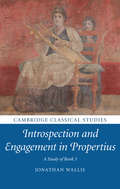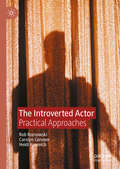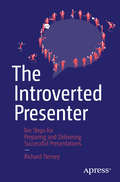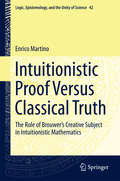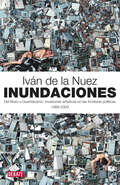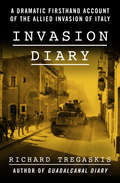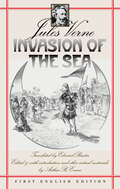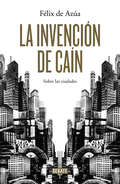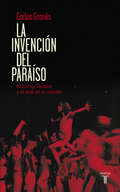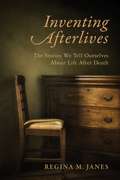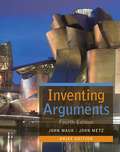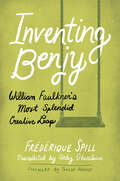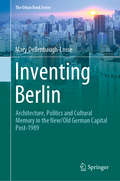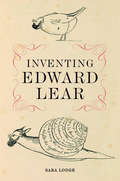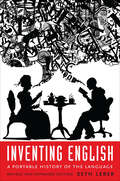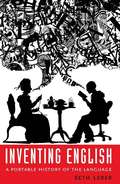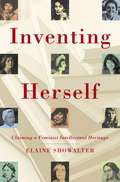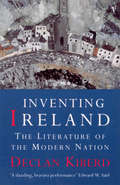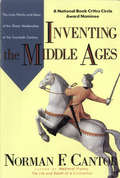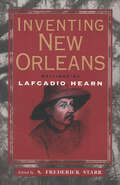- Table View
- List View
Introspection and Engagement in Propertius: A Study Of Book 3 (Cambridge Classical Studies)
by Jonathan WallisPropertius re-invents Latin love-elegy in his third collection. <P><P>Nearly a decade into the Augustan principate, the early counter-cultural impulse of Propertius' first collections was losing its relevance. Challenged by the publication of Horace's Odes, and by the imminent arrival of Virgil's Aeneid, in 23 BCE Propertius produced a radical collection of elegy which critically interrogates elegy's own origins as a genre, and which directly faces off Horatian lyric and Virgilian epic, as part of an ambitious claim to Augustan pre-eminence. <P>But this is no moment of cultural submission. In Book 3, elegy's key themes of love, fidelity, and political independence are rebuilt from the beginning as part of a subtle critique of emerging Augustan mores. This book presents a series of readings of fourteen individual elegies from Propertius Book 3, including nostalgic love poems, an elegiac hymn to Bacchus, and a lament for Marcellus, the recently-dead nephew of Augustus.<P> Argues for an interpretation of one complete collection of poetry on its own terms.<P> Explores the interaction between Propertius and the significant contemporary Augustan poets Horace and Virgil.<P> Examines the development of elegy as a genre.
The Introverted Actor: Practical Approaches
by Rob Roznowski Carolyn Conover Heidi KasevichDo you have to be an extrovert to succeed as an actor? This book offers ideas to create inclusive acting environments where the strengths of the introverted actor are as valued as those of their extroverted counterparts. As this book shows, many introverts are innately drawn to the field of acting, but can often feel inferior to their extroverted peers. From the classroom to professional auditions, from rehearsals to networking events, introverted actors tell their stories to help other actors better understand how to leverage their natural gifts, both onstage and off. In addition, The Introverted Actor helps to reimagine professional and pedagogical approaches for both actor educators and directors by offering actionable advice from seasoned psychology experts, professional actors, and award-winning educators.
The Introverted Presenter
by Richard TierneyThe introvert is a personality type that draws energy from the outside inward. According to standard personality testing assessments, most people are introverts and no group is more introverted than technical professionals. Introverts are congenitally programmed to recoil from the prospect of public speaking with fear and loathing, yet making presentations to expert and non-expert audiences is an inescapable requirement for career advancement in any technical field. Presentation coach Richard Tierney rides to the rescue of fellow introverts in the IT and engineering sectors with The Introverted Presenter--his fail-safe guide to delivering competent presentations, no matter how unsuited by nature you might be to the performing arts. This short book lays out the complete process guaranteed to raise you from a debilitating state of terror and aversion to a comfortable place of clarity, calm, and competence--perhaps even brilliance, if you can train yourself to convert the free energy of your fear into controlled performance. Tierney repeatedly warns his introvert readers that they risk presentation fiasco if they skip, skimp, or change the order of any of the ten steps he prescribes for thoroughly and efficiently preparing their presentations. The surefire sequence of steps for The Introverted Presenter begins with defining your presentation''s audience and objective. The next step is to write the script of your speech in stages, constructing it on the basis of proven structural rules, cognitive laws, and dramatic tricks. Then you incrementally refine and tighten your script by delivering it iteratively, first in front of a mirror and then in front of increasingly critical test audiences, progressing from your cat to your boss. When you have a well-constructed and sound-tested script in hand and only then, you may create some slides to graft into your script in support of your opening action call and your concluding takeaways, which you commit to memory. Your slides should be limited to the smallest number possible (even zero) and the fewest possible words. What you''ll learn By following the process precisely as described in this book, even the most introverted technology professional will gradually but surely acquire the ability to Structure a killer presentation Coach yourself into being the best performer you can be Craft a presentation that supplies your audience''s technical needs while activating its human sympathies Use slides sparingly for best supporting effect Deploy elements of stagecraft like a trouper Who this book is for The primary readership is technology professionals who ordinarily shun the public-speaking limelight but find they need to pitch their work outside their team environments. The secondary readership is non-extroverts in the corporate, commercial, or academic worlds who have taken career promotions that involve presentations as part of their job descriptions. Table of Contents Chapter 1. Introverts and Presentations: Harnessing Terror Chapter 2. Face the Presentation Specter: Feared More Than Death Chapter 3. Find Your Presentation''s Focus: Ready, Steady Chapter 4. Impose Your Presentation''s Structure: Taking the Reins Chapter 5. Write Your Speech: Fear Returns Chapter 6. Refine Your Speech: Relishing the Panic Chapter 7. Try On Your Presenting Persona: Trotting the Course Chapter 8. Master Your Presentation Technology: Bending the Servant to Your Will Chapter 9. Chunk Your Presentation: Linking Primacy, Latency, and Failsafe Devices Chapter 10. Rehearse Your Presentation: Practice, Practice till Thoroughly Bored Chapter 11. Deliver Your Presentation: Treading the Hustings Like a Trouper Chapter 12. Encore! Rolling On to Your Next Presentation Chapter 13. Instant Clarity: Scaring Up an Emergency Presentation in One Day
Intuitionistic Proof Versus Classical Truth: The Role Of Brouwer's Creative Subject In Intuitionistic Mathematics (Logic, Epistemology, and the Unity of Science #42)
by Enrico MartinoThis book examines the role of acts of choice in classical and intuitionistic mathematics. Featuring fifteen papers – both new and previously published – it offers a fresh analysis of concepts developed by the mathematician and philosopher L.E.J. Brouwer, the founder of intuitionism.The author explores Brouwer’s idealization of the creative subject as the basis for intuitionistic truth, and in the process he also discusses an important, related question: to what extent does the intuitionistic perspective succeed in avoiding the classical realistic notion of truth? The papers detail realistic aspects in the idealization of the creative subject and investigate the hidden role of choice even in classical logic and mathematics, covering such topics as bar theorem, type theory, inductive evidence, Beth models, fallible models, and more. In addition, the author offers a critical analysis of the response of key mathematicians and philosophers to Brouwer’s work. These figures include Michael Dummett, Saul Kripke, Per Martin-Löf, and Arend Heyting.This book appeals to researchers and graduate students with an interest in philosophy of mathematics, linguistics, and mathematics.
Intuitions in Literature, Technology, and Politics: Parabilities (American Literature Readings in the 21st Century)
by Alan Ramón ClintonUsing the idea of 'parability,'or the ability for writers to tell improper stories, as a foundation, Alan Ramón Clinton synthesizes a new model for a creative, more daring literary criticism. Sharp and surprising, this wide-ranging project engages with the work of Pynchon, Eco, Forché, Merrill, Weiner, Plath, Ashbery, and Eigner.
Inundaciones: Del Muro a Guantánamo: invasiones artísticas en las fronteras políticas
by Iván de NuezUn repaso a los grandes temas del arte contemporáneo desde 1989. Veinte años de transformaciones políticas. Veinte años de arte contemporáneo. Solo veinte años van de la caída del muro al desmantelamiento de la prisión de Guantánamo. Del fin de la Guerra Fría a la confirmación de la impotencia estadounidense para controlar el mundo que surgió del colapso comunista. A modo de dietario, con un capítulo por cada uno de los 21 años transcurridos, Iván de la Nuez recorre, con su brillantez habitual, todos los recovecos de nuestra experiencia para iluminar el impacto del arte en la historia contemporánea, y de la historia contemporánea en el arte. Un ensayo que demuestra la irremediable unión que existe entre arte, política y sociedad
Invalid Women
by Diane Price Herndl"A fine example of politically engaged literary criticism.--Belles Lettres "Price Herndl's compelling individual readings of works by major writers (Harriet Beecher Stowe, Hawthorne, Wharton, James, Fitzgerald) and minor ones complement her examination of germ theory, psychic and somatic cures, medicine's place in the rise of capitalism, and the cultural forms in which men and women used the trope of female illness.--Choice "A rich and provocative study of female illnesses and their textual representations. . . . A major contribution to the feminist agenda of literature and medicine.--Medical Humanities Review "[An] important book.--Nineteenth-Century Literature "[This] sophisticated new study . . . brings the best current strategies of a thoroughly historicized feminist literary criticism to bear on textual representations of female invalidism.--Feminist Studies "An outstanding study of the representation of female invalidism in American culture and literature. There emerges from this work a striking sense of the changing meanings of female invalidism even as the conjunction of these terms has remained a constant in American cultural history. . . . Moreover, Invalid Women provides fascinating readings of female illness in a variety of texts.--Gillian Brown, University of Utah "A provocative study based on imaginative historical research and very fine close readings. The book provides a useful American complement to Helena Michie's The Flesh Made Word and Margaret Homans's Bearing the World. It should prove enlightening and otherwise useful not just to scholars of American literature, but also to those engaged in American studies, feminist criticism and theory, women's studies, the sociology of medicine and illness, and the history of science and medicine.--Cynthia S. Jordan, Indiana University
Invasion Diary: A Dramatic Firsthand Account of the Allied Invasion of Italy
by Richard TregaskisA dramatic and richly detailed chronicle of the Allied invasions of Sicily and Italy from one of America&’s greatest war correspondents. Following the defeat of Axis forces in North Africa, Allied military strategists turned their attention to southern Italy. Winston Churchill famously described the region as the &“soft underbelly of Europe,&” and claimed that an invasion would pull German troops from the Eastern Front and help bring a swift end to the war. On July 10, 1943, American and British forces invaded Sicily. Operation Husky brought the island under Allied control and hastened the downfall of Benito Mussolini, but more than one hundred thousand German and Italian troops managed to escape across the Strait of Medina. The &“soft underbelly&” of mainland Italy became, in the words of US Fifth Army commander Lt. Gen. Mark Clark, &“a tough old gut.&” Less than a year after landing with the US Marines on Guadalcanal Island, journalist Richard Tregaskis joined the Allied forces in Sicily and Italy. Invasion Diary documents some of the fiercest fighting of World War II, from bombing runs over Rome to the defense of the Salerno beachhead against heavy artillery fire to the fall of Naples. In compelling and evocative prose, Tregaskis depicts the terror and excitement of life on the front lines and recounts his own harrowing brush with death when a chunk of German shrapnel pierced his helmet and shattered his skull. An invaluable eyewitness account of two of the most crucial campaigns of the Second World War and a stirring tribute to the soldiers, pilots, surgeons, nurses, and ambulance drivers whose skill and courage carried the Allies to victory, Invasion Diary is a classic of war reportage and &“required reading for all who want to know how armies fight&” (Library Journal). This ebook features an illustrated biography of Richard Tregaskis including rare images from the American Heritage Center at the University of Wyoming.
Invasion of the Sea (Early Classics of Science Fiction)
by Jules VerneFirst English edition of a classic Verne novel. Jules Verne, celebrated French author of Twenty Thousand Leagues Under the Sea and Around the World in 80 Days, wrote over 60 novels collected in the popular series "Voyages Extraordinaires." A handful of these have never been translated into English, including Invasion of the Sea, written in 1904 when large-scale canal digging was very much a part of the political, economic, and military strategy of the world's imperial powers. Instead of linking two seas, as existing canals (the Suez and the Panama) did, Verne proposed a canal that would create a sea in the heart of the Sahara Desert. The story raises a host of concerns — environmental, cultural, and political. The proposed sea threatens the nomadic way of life of those Islamic tribes living on the site, and they declare war. The ensuing struggle is finally resolved only by a cataclysmic natural event. This Wesleyan edition features notes, appendices and an introduction by Verne scholar Arthur B. Evans, as well as reproductions of the illustrations from the original French edition.
La invención de Cain
by Félix De AzúaLos mejores escritos de Félix de Azúa sobre ciudades y ciudadanos, sobre urbes y urbanitas. Este libro recoge -ahora en una nueva edición corregida y aumentada- los escritos de Félix de Azúa sobre la ciudad, un compendio de crónicas de viaje, reflexiones, observaciones, panorámicas e interiores que conforma una lúcida y bella meditación acerca de ese espacio pétreo que a lo largo de la historia se ha ido convirtiendo en el único hogar del hombre. En estas páginas, siempre con inteligencia y humor, Azúa viaja a Venecia, Munich, Berlín, Hamburgo, Basilea, Madrid o Sevilla, examina a ciudadanos, políticos y turistas, descubre olvidados rincones, revive calles desaparecidas y, sobre todo, sigue manteniendo un diálogo tenso con la literatura y las artes como máxima expresión de lo humano en el seno de la urbe.
La invención del paraíso
by Carlos Granés¿Puede el arte transformar la sociedad? El Living Theatre es el último intento de revolución desde la cultura. Es la historia de una utopía, de sus contradicciones y de su imposibilidad. ¿Influye de alguna manera el arte sobre el ser humano? ¿Transforma su conciencia? ¿Cambia su vida? En la apasionante historia cultural del siglo XX nadie intentó responder estas preguntas con tanto empeño como el Living Theatre. Eslabón entre la vanguardia europea, la generación beat, el hippismo y el tercermundismo, el legendario grupo de teatro experimental liderado por Judith Malina y Julian Beck se planteó un ambicioso objetivo: primero quisieron revolucionar la sociedad estadounidense con sus obras, en especial con Paradise Now, y luego liberar a los brasileños sometidos por la dictadura militar del general Médici con otrade sus creaciones, El legado de Caín, inspirada en las turbulentas novelas de Sacher-Masoch. Lanzaron una revolución cultural en una democracia y meses después en una dictadura. ¿Cuáles fueron los resultados de esas dos batallas? ¿Logró el Living Theatre cambiar la realidad? Tanto en su peregrinaje a lo largo y ancho de Estados Unidos llevando el mensaje de Paradise Now, como en su búsqueda de los más pobres entre los pobres en las favelas y barriadas de São Paulo, Río de Janeiro y Ouro Preto, el grupo se reunió y conspiró con las grandes personalidades de la cultura de todo el continente. Quiso inventar un Paraíso y finalmente lo consiguió. Pero, ¿era el que buscaba? Hasta el día de hoy, el Living Theatre ha luchado por ampliar la esfera de libertades, actuando no solo con osadía, sino con valentía, para desafiar el autoritarismo y las convenciones que acotan la libertad individual. La crítica ha dicho... «Este ensayo es ideal para entender el papel del teatro experimental en el avance de la sociedad a través de sus propuestas políticas y de una suerte de utopía comunitaria.» La Razón
Inventing Afterlives: The Stories We Tell Ourselves About Life After Death
by Regina M. JanesWhy is belief in an afterlife so persistent across times and cultures? And how can it coexist with disbelief in an afterlife? Most modern thinkers hold that afterlife belief serves such important psychological and social purposes as consoling survivors, enforcing morality, dispensing justice, or giving life meaning. Yet the earliest, and some more recent, afterlives strikingly fail to satisfy those needs.In Inventing Afterlives, Regina M. Janes proposes a new theory of the origins of the hereafter rooted in the question that a dead body raises: where has the life gone? Humans then and now, in communities and as individuals, ponder what they would want or experience were they in that body. From this endlessly recurring situation, afterlife narratives develop in all their complexity, variety, and ingenuity. Exploring afterlives from Egypt to Sumer, among Jews, Greeks, and Romans, to Christianity’s advent and Islam’s rise, Janes reveals how little concern ancient afterlives had with morality. In south and east Asia, karmic rebirth makes morality self-enforcing and raises a new problem: how to stop re-dying. The British enlightenment, Janes argues, invented the now widespread wish-fulfilling afterlife and illustrates how afterlives change. She also considers the surprising afterlife of afterlives among modern artists and writers who no longer believe in worlds beyond this one. Drawing on a variety of religious traditions; contemporary literature and film; primatology; cognitive science; and evolutionary psychology, Janes shows that in asking what happens after we die, we define the worlds we inhabit and the values by which we live.
Inventing Arguments: Brief 4th Edition
by John Mauk John MetzOrganized around common rhetorical situations that occur all around us, INVENTING ARGUMENTS shows you that argument is a living process rather than a form to be modeled. Through the text's prominent focus on invention, you will learn to recognize the rhetorical elements of any argumentative situation and apply the tools of argument effectively in your own writing. The basic layers of argument are introduced in early chapters, with material arranged into increasingly sophisticated topics beginning with the most obvious or explicit layers (claims) and moving to more implied or "hidden" layers (assumptions, values, beliefs, ideology). By the time you finish Part 1, you will have a thorough understanding of argument, which you can then apply not just to the invention projects but also to your writing for other college courses and beyond.
Inventing Benjy: William Faulkner’s Most Splendid Creative Leap
by Frédérique SpillInventing Benjy: William Faulkner’s Most Splendid Creative Leap is a groundbreaking work at the intersection of Faulkner studies and disability studies. Originally published in 2009 by Presses de la Sorbonne Nouvelle as L’Idiotie dans l’œuvre de Faulkner, this translation brings the book to English-language readers for the first time. Author Frédérique Spill begins with a sustained look at the monologue of Benjy Compson, the initial first-person narrator in Faulkner’s The Sound and the Fury. Spill questions the reasons for this narrative choice, bringing readers to consider Benjy’s monologue, which is told by a narrator who is deaf and cognitively disabled, as an impossible discourse. This paradoxical discourse, which relies mostly on senses and sensory perception, sets the foundation of a sophisticated poetics of idiocy. Using this form of writing, Faulkner shaped perspective from a disabled character, revealing a certain depth to characters that were previously only portrayed on a shallow level. This style encompasses some of the most striking forms and figures of his leap into modern(ist) writing. In that respect, Inventing Benjy thoroughly examines Benjy’s discourse as an experimental workshop in which objects and words are exclusively modelled by the senses. This study regards Faulkner’s decision to place a disabled character at the center of perception as the inaugural and emblematic gesture of his writing. Closely examining excerpts from Faulkner’s novels and a few short stories, Spill emphasizes how the corporal, temporal, sensorial, and narrative figures of "idiocy" are reflected throughout Faulkner’s work. These writing choices underlie some of his most compelling inventions and certainly contribute to his unmistakable writing style. In the process, Faulkner’s writing takes on a phenomenological dimension, simultaneously dismantling and reinventing the intertwined dynamics of perception and language.
Inventing Berlin: Architecture, Politics and Cultural Memory in the New/Old German Capital Post-1989 (The Urban Book Series)
by Mary Dellenbaugh-LosseThis book comprehensively examines post-1989 changes to the symbolic landscape of Berlin – specifically, street names, architecture, urban planning and monuments – and links these changes to concepts of contested cultural memory and national identity in Berlin and Germany in the post-Wall period. The core of the book is made up of an analysis of built space changes in the eastern half of the city before and after the Berlin Wall, flanked by an introduction to the theoretical underpinnings of the topic and a wider interpretation of the events in Berlin in relation to other geographic and historical contexts. It furthermore offers an explanatory model for the phenomenon of the "symbolic foreigner" whereby former citizens of the GDR feel disenfranchised and excluded from today's German society. This book is a valuable resource for researchers, students, and also appeals to a wider, non-academic audience with an interest in both cultural memory and Berlin.
Inventing Edward Lear
by Sara LodgeEdward Lear—the father of nonsense—wrote some of the best-loved poems in English. He was also admired as a naturalist, landscape painter, travel writer, and composer. Awkward but funny, absurdly sympathetic, Lear invented himself as a Victorian character. Sara Lodge offers a moving account of one of the era’s most influential creative figures.
Inventing English: A Portable History of the Language
by Seth LererSeth Lerer tells a masterful history of the English language from the age of Beowulf to the rap of Eminem. Many have written about the evolution of grammar, pronunciation, and vocabulary, but only Lerer situates these developments within the larger history of English, America, and literature. This edition features a new chapter on the influence of biblical translation and an epilogue on the relationship of English speech to writing. A unique blend of historical and personal narrative, Inventing English is the surprising tale of a language that is as dynamic as the people to whom it belongs.
Inventing English: A Portable History of the Language
by Seth LererWhy is there such a striking difference between English spelling and English pronunciation? How did our seemingly relatively simple grammar rules develop? What are the origins of regional dialect, literary language, and everyday speech, and what do they have to do with you? Seth Lerer's Inventing English is a masterful, engaging history of the English language from the age of Beowulf to the rap of Eminem. Many have written about the evolution of our grammar, pronunciation, and vocabulary, but only Lerer situates these developments in the larger history of English, America, and literature.Lerer begins in the seventh century with the poet Caedmon learning to sing what would become the earliest poem in English. He then looks at the medieval scribes and poets who gave shape to Middle English. He finds the traces of the Great Vowel Shift in the spelling choices of letter writers of the fifteenth century and explores the achievements of Samuel Johnson's Dictionary of 1755 and The Oxford English Dictionary of the late nineteenth and early twentieth centuries. He describes the differences between English and American usage and, through the example of Mark Twain, the link between regional dialect and race, class, and gender. Finally, he muses on the ways in which contact with foreign languages, popular culture, advertising, the Internet, and e-mail continue to shape English for future generations. Each concise chapter illuminates a moment of invention-a time when people discovered a new form of expression or changed the way they spoke or wrote. In conclusion, Lerer wonders whether globalization and technology have turned English into a world language and reflects on what has been preserved and what has been lost. A unique blend of historical and personal narrative, Inventing English is the surprising tale of a language that is as dynamic as the people to whom it belongs.
Inventing English: A Portable History of the Language
by Seth LererA history of English from the age of Beowulf to the rap of Eminem, &“written with real authority, enthusiasm and love for our unruly and exquisite language&” (The Washington Post). Many have written about the evolution of grammar, pronunciation, and vocabulary, but only Seth Lerer situates these developments within the larger history of English, America, and literature. This edition of his &“remarkable linguistic investigation&” (Booklist) features a new chapter on the influence of biblical translation and an epilogue on the relationship of English speech to writing. A unique blend of historical and personal narrative, both &“erudite and accessible&” (The Globe and Mail), Inventing English is the surprising tale of a language that is as dynamic as the people to whom it belongs. &“Lerer is not just a scholar; he's also a fan of English—his passion is evident on every page of this examination of how our language came to sound—and look—as it does and how words came to have their current meanings…the book percolates with creative energy and will please anyone intrigued by how our richly variegated language came to be.&”—Publishers Weekly (starred review)
Inventing Hell
by Jon M. SweeneyHell: The word means terror, darkness, and eternal separation from God. Some people think the Bible is clear about hell, but what if they're mistaken? With gripping narrative and solid scholarship, Sweeney charts hell's "evolution" from the Old Testament underworld Sheol, through history and literature, to the greatest influencer of all: Dante's Inferno. He reveals how the modern idea of hell is based mostly on Dante's imaginative genius-but in the process, he offers a more constructive understanding of the afterlife than ever before. Disturbing and enthralling, Sweeney will forever alter what we think happens to us after we die-and more importantly, he will make us reconsider how we live. Bible really says about heaven and hell, giving us a clearer, more hopeful understanding of the afterlife than ever before.
Inventing Herself: Claiming a Feminist Intellectual Heritage
by Elaine ShowalterSure to take its place alongside the literary landmarks of modern feminism, Elaine Showalter's brilliant, provocative work chronicles the roles of feminist intellectuals from the eighteenth century to the present. With sources as diverse as A Vindication of the Rights of Woman and Scream 2, Inventing Herself is an expansive and timely exploration of women who possess a boundless determination to alter the world by boldly experiencing love, achievement, and fame on a grand scale. These women tried to work, travel, think, love, and even die in ways that were ahead of their time. In doing so, they forged an epic history that each generation of adventurous women has rediscovered. Focusing on paradigmatic figures ranging from Mary Wollstonecraft and Margaret Fuller to Germaine Greer and Susan Sontag, preeminent scholar Elaine Showalter uncovers common themes and patterns of these women's lives across the centuries and discovers the feminist intellectual tradition they embodied. The author brilliantly illuminates the contributions of Eleanor Marx, Zora Neale Hurston, Simone de Beauvoir, Margaret Mead, and many more. Showalter, a highly regarded critic known for her provocative and strongly held opinions, has here established a compelling new Who's Who of women's thought. Certain to spark controversy, the omission of such feminist perennials as Susan B. Anthony, Eleanor Roosevelt, and Virginia Woolf will surprise and shock the conventional wisdom. This is not a history of perfect women, but rather of real women, whose mistakes and even tragedies are instructive and inspiring for women today who are still trying to invent themselves.
Inventing High and Low: Literature, Mass Culture, and Uneven Modernity in Spain
by Stephanie SieburthDire word of the cultural threat of the lowbrow goes back at least to the ancient Greeks, and yet, Stephanie Sieburth suggests, no division between "high" and "low" culture will stand up to logical scrutiny. Why, then, does the opposition persist? In this book Sieburth questions the terms of this perennial debate and uncovers the deep cultural, economic, and psychological tensions that lead each generation to reinvent the distinction between high and low. She focuses on Spain, where this opposition plays a special role in notions of cultural development and where leading writers have often made the relation of literature to mass culture the theme of their novels. Choosing two historical moments of sweeping material and cultural change in Spanish history, Sieburth reads two novels from the 1880s (by Benito Pérez Galdós) and two from the 1970s (by Juan Goytisolo and Carmen Martín Gaite) as fictional theories about the impact of modernity on culture and politics. Her analysis reveals that the high/low division in the cultural sphere reinforces other kinds of separations--between social classes or between men and women--dear to the elite but endangered by progress. This tension, she shows, is particularly evident in Spain, where modernization has been a contradictory and uneven process, rarely accompanied by political freedom, and where consumerism and mass culture coexist uneasily with older ways of life. Weaving together a wide spectrum of diverse material, her work will be of interest to readers concerned with Spanish history and literature, literary theory, popular culture, and the relations between politics, economics, gender, and the novel.
Inventing Ireland: The Literature of a Modern Nation
by Declan KiberdKiberd - one of Ireland's leading critics and a central figure in the FIELD DAY group with Brian Friel, Seamus Deane and the actor Stephen Rea - argues that the Irish Literary Revival of the 1890-1922 period embodied a spirit and a revolutionary, generous vision of Irishness that is still relevant to post-colonial Ireland. This is the perspective from which he views Irish culture. His history of Irish writing covers Yeats, Lady Gregory, Synge, O'Casey, Joyce, Beckett, Flann O'Brien, Elizabeth Bowen, Heaney, Friel and younger writers down to Roddy Doyle.
Inventing The Middle Ages
by Norman F. CantorINVENTING THE MIDDLE AGESThe Lives, Works, and Ideas of the Great Medievalists of the Twentieth CenturyIn this ground-breaking work, Norman Cantor explains how our current notion of the Middle Ages-with its vivid images of wars, tournaments, plagues, saints and kings, knights and ladies-was born in the twentieth century. The medieval world was not simply excavated through systematic research. It had to be conceptually created: It had to be invented, and this is the story of that invention. Norman Cantor focuses on the lives and works of twenty of the great medievalists of this century, demonstrating how the events of their lives, and their spiritual and emotional outlooks, influenced their interpretations of the Middle Ages. Cantor makes their scholarship an intensely personal and passionate exercise, full of color and controversy, displaying the strong personalities and creative minds that brought new insights about the past. A revolution in academic method, this book is a breakthrough to a new way of teaching the humanities and historiography, to be enjoyed by student and general public alike. It takes an immense body of learning and transmits it so that readers come away fully informed of the essentials of the subject, perceiving the interconnection of medieval civilization with the culture of the twentieth century and having had a good time while doing it! This is a riveting, entertaining, humorous, and learned read, compulsory for anyone concerned about the past and future of Western civilization.
Inventing New Orleans: Writings of Lafcadio Hearn
by S. Frederick StarrLafcadio Hearn (1850-1904) prowled the streets of New Orleans from 1877 to 1888 before moving on to a new life and global fame as a chronicler of Japan. Hearn's influence on our perceptions of New Orleans, however, has unjustly remained unknown. In ten years of serving as a correspondent and selling his writing in such periodicals as the New Orleans Daily Item, Times-Democrat, Harper's Weekly, and Scribner's Magazine he crystallized the way Americans view New Orleans and its south Louisiana environs. Hearn was prolific, producing colorful and vivid sketches, vignettes, news articles, essays, translations of French and Spanish literature, book reviews, short stories, and woodblock prints. He haunted the French Quarter to cover such events as the death of Marie Laveau. His descriptions of the seamy side of New Orleans, tainted with voodoo, debauchery, and mystery made a lasting impression on the nation. Denizens of the Crescent City and devotees who flock there for escapades and pleasures will recognize these original tales of corruption, of decay and benign frivolity, and of endless partying. With his writing, Hearn virtually invented the national image of New Orleans as a kind of alternative reality to the United States as a whole. S. Frederick Starr, a leading authority on New Orleans and Louisiana culture, edits the volume, adding an introduction that places Hearn in a social, historical, and literary context. Hearn was sensitive to the unique cultural milieu of New Orleans and Louisiana. During the decade that he spent in New Orleans, Hearn collected songs for the well-known New York music critic Henry Edward Krehbiel and extensively studied Creole French, making valuable and lasting contributions to ethnomusicology and linguistics. Hearn's writings on Japan are famous and have long been available. But Inventing New Orleans: Writings of Lafcadio Hearn brings together a selection of Hearn's nonfiction on New Orleans and Louisiana, creating a previously unavailable sampling. In these pieces Hearn, an Anglo-Greek immigrant who came to America by way of Ireland, is alternately playful, lyrical, and morbid. This gathering also features ten newly discovered sketches. Using his broad stylistic palette, Hearn conjures up a lost New Orleans which later writers such as William Faulkner and Tennessee Williams used to evoke the city as both reality and symbol.
